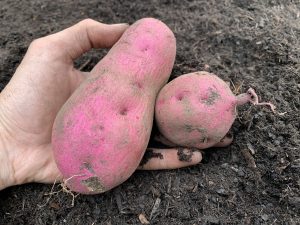About 12,000 years ago, farming was ‘invented’ (History, 2019). One could reasonably assume that 12,000 years is enough time for civilization to master the techniques of agriculture and develop technologies that could feed every mouth, every day, every time, but according to the State of Food Security and Nutrition in the World 2018, about 821 million people, or one in every ninth person, were suffering from chronic undernourishment in 2017 (Food and Agriculture Organization of the United Nations, 2018). Of the 821 million people starving, majority of them live in developing countries in South America and Africa (FAO, 2018). As the world continues to grow hungrier and the climate continues to change, society will need to adapt and innovate to reduce vulnerability and chaos.
In August of 2013, Guam imported over 1M dollars’ worth of fruits and vegetables (Bureau of Plans and Statistics, 2013). This is troubling information because relying heavily on food imports could negatively impact a society if the food source suddenly hits a disaster such as, drought or floods. Loss of food availability in Guam’s food-imported nations could lead to food shortages and famine on Guam. To combat this, Guam needs to adopt a community-driven, sustainable agriculture system for its citizens and later possibly import to neighboring islands. With the increase of extreme weathering across the globe and increase in global temperatures, the idea of food shortages is not a topic of if it will happen but how quickly it will affect our food supply.
Since most of Guam live in concrete buildings, Guamanians can grow a diagonal garden that attaches from the top of the building to the ground. Planting vegetables along the bottom of the garden such as, cucumbers, bitter melon, tomatoes and legumes in every house could cut Guam’s reliance on imports of those foods. This would not only decrease reliance on imports but also increase food security, healthy dieting and cool the temperatures of the house. According to Dr. Helen Delichatsios, an internist at Harvard-affiliated Massachusetts General Hospital, “Backyard gardening can inspire you to take an interest in the origins of your food and make better choices about what you put on your plate,” she also states, “When you grow your own food, you savor it more because of the effort it took to get to the table.” One problem to this idea is that the system requires regular maintenance, so the people of Guam would need to learn to regularly maintain a garden in order to adopt this system and provide for the whole community.
To test this project, I will request from Sea Grant Director Dr. Austin Shelton to use a building in UOG Dean’s Circle. Afterwards, I will collect my materials: netting, soil, hooks, plants and concrete blocks. Then, I will attach the netting to the top of the building and secure it on the ground. After that, I will place soil around the base of the anchored net and plant cucumbers. Cucumbers grow very well on trellises on Guam. I anticipate that this project will take me about 3 months to collect data. Throughout the three months, I will collect the growth of the cucumbers, how valuable and reliable the yield is and document maintenance procedures. Afterwards, I will publish the data and share cucumber salad with others.
Work Cited
Global hunger continues to rise, new UN report says. (n.d.). Retrieved from http://www.fao.org/news/story/en/item/1152031/icode/
Godman, H. (2012, June 29). Backyard gardening: grow your own food, improve your health. Retrieved from https://www.health.harvard.edu/blog/backyard-gardening-grow-your-own-food-improve-your-health-201206294984
Guam Bureau of Statistics and Plans. (2013). Guam Import Data.
History.com Editors. (2018, January 12). Neolithic Revolution. Retrieved from https://www.history.com/topics/pre-history/neolithic-revolution



